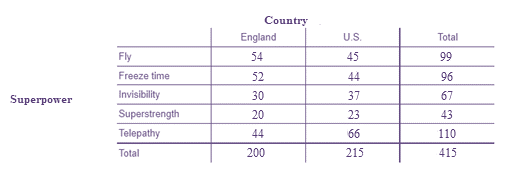
Concept explainers
(a)
Probability for the child from England prefers Telepathy.
(a)
Answer to Problem 61E
Probability for the child from England prefers Telepathy,
Explanation of Solution
Given information:
Data for superpowers in the two − way table:

According to conditional probability,
We know
E: England
T: Telepathy
Note that
The information about 415 children is provided in the table.
Thus,
The number of possible outcomes is 415.
Also note that
In the table, 200 of the 415 children are from England.
Thus,
The number of favorable outcomes is 200.
When the number of favorable outcomes is divided by the number of possible outcomes, we get the probability.
Now,
Note that
In the table, 44 of the 415 children are from England and prefer Telepathy. In this case, the number of favorable outcomes is 44 and number of possible outcomes is 415.
Apply conditional probability:
Therefore,
Around 22% of the children from England prefer Telepathy and the probability for the child from England prefers Telepathy is 0.22.
(b)
Probability for the child from England did not choose superstrength.
(b)
Answer to Problem 61E
Probability that the child from England did not choose superstrength,
Explanation of Solution
Given information:
Data for superpowers in the two − way table:

According to complement rule,
According to conditional probability,
We know
E: England
S: Superstrength
Note that
The information about 415 children is provided in the table.
Thus,
The number of possible outcomes is 415.
Also note that
In the table, 43 of the 415 children from both the countries prefer superstrength.
Thus,
The number of favorable outcomes is 43.
When the number of favorable outcomes is divided by the number of possible outcomes, we get the probability.
Apply complement rule:
Now,
Note that
In the table, 20 children from total 200 children from England prefer Superstrength.
That means
Remaining 180 children from total 200 children from England do not prefer Superstrength.
In this case, the number of favorable outcomes is 180.
Since the total children from both the countries are 415.
Thus,
The number of possible outcomes is 415.
Apply conditional probability:
Therefore,
Around 48.39% children not preferring Superstrength are from England and the probability for child from England did not prefer Superstrength is 0.4839.
Chapter 5 Solutions
PRACTICE OF STATISTICS F/AP EXAM
Additional Math Textbook Solutions
Elementary Statistics: Picturing the World (6th Edition)
Elementary Statistics
Statistics for Business and Economics (13th Edition)
Elementary Statistics Using Excel (6th Edition)
Introductory Statistics
 MATLAB: An Introduction with ApplicationsStatisticsISBN:9781119256830Author:Amos GilatPublisher:John Wiley & Sons Inc
MATLAB: An Introduction with ApplicationsStatisticsISBN:9781119256830Author:Amos GilatPublisher:John Wiley & Sons Inc Probability and Statistics for Engineering and th...StatisticsISBN:9781305251809Author:Jay L. DevorePublisher:Cengage Learning
Probability and Statistics for Engineering and th...StatisticsISBN:9781305251809Author:Jay L. DevorePublisher:Cengage Learning Statistics for The Behavioral Sciences (MindTap C...StatisticsISBN:9781305504912Author:Frederick J Gravetter, Larry B. WallnauPublisher:Cengage Learning
Statistics for The Behavioral Sciences (MindTap C...StatisticsISBN:9781305504912Author:Frederick J Gravetter, Larry B. WallnauPublisher:Cengage Learning Elementary Statistics: Picturing the World (7th E...StatisticsISBN:9780134683416Author:Ron Larson, Betsy FarberPublisher:PEARSON
Elementary Statistics: Picturing the World (7th E...StatisticsISBN:9780134683416Author:Ron Larson, Betsy FarberPublisher:PEARSON The Basic Practice of StatisticsStatisticsISBN:9781319042578Author:David S. Moore, William I. Notz, Michael A. FlignerPublisher:W. H. Freeman
The Basic Practice of StatisticsStatisticsISBN:9781319042578Author:David S. Moore, William I. Notz, Michael A. FlignerPublisher:W. H. Freeman Introduction to the Practice of StatisticsStatisticsISBN:9781319013387Author:David S. Moore, George P. McCabe, Bruce A. CraigPublisher:W. H. Freeman
Introduction to the Practice of StatisticsStatisticsISBN:9781319013387Author:David S. Moore, George P. McCabe, Bruce A. CraigPublisher:W. H. Freeman





